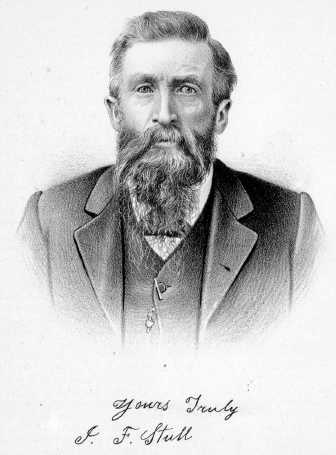low-citizens, and in him they find
one who is always ready to co-operate with them to
advance the interests of the city or county. He was
elected County Commissioner in 1882, and was
re-elected to that important office in 1883, and again
in 1888. While acting in that capacity he paid close
attention to the duties devolving upon him,
discharging them in such a manner as to give general
satisfaction, and his official career is without a
stain. He is a leading Republican in Cass County, and
he has been a delegate to numerous conventions of his
party. He cast his first vote for Abraham Lincoln, and
has since been a stanch supporter of the party.

 OHN
FREDERICK STULL. (This name was always spelled in the
German language by his ancestors, Stoll. His father
also spelled it Stoll, but John F., our subject,
changed the spelling to Stull, after he became old
enough to do business for himself. When he writes in
German he spells it Stoll, in English, Stull hence
this explanation). Mr. Stull was a pioneer of
Nebraska, and to him and men of like decision, courage
and practical energy, Cass County, of which he was an
early settler, is greatly indebted for its high rank
among its sister counties in regard to commerce,
agriculture, and the various interests that go to make
up a prosperous and wealthy community. He is
prominently identified with the farming and
stock-raising interests of Plattsmouth Township, where
he has a large and valuable farm and a pleasant,
commodious home. OHN
FREDERICK STULL. (This name was always spelled in the
German language by his ancestors, Stoll. His father
also spelled it Stoll, but John F., our subject,
changed the spelling to Stull, after he became old
enough to do business for himself. When he writes in
German he spells it Stoll, in English, Stull hence
this explanation). Mr. Stull was a pioneer of
Nebraska, and to him and men of like decision, courage
and practical energy, Cass County, of which he was an
early settler, is greatly indebted for its high rank
among its sister counties in regard to commerce,
agriculture, and the various interests that go to make
up a prosperous and wealthy community. He is
prominently identified with the farming and
stock-raising interests of Plattsmouth Township, where
he has a large and valuable farm and a pleasant,
commodious home.
Mr. Stull was born in Germany, May
13, 1831, and in October, 1834, he came with his
parents, Henry and Elizabeth (Degen) Stoll, to the
United States. They were likewise natives of Germany,
as had been their ancestors as far back as known. They
located in Pike County, Ohio, where the mother, a
woman of genuine worth, passed away from the scenes of
earth Oct. 20, 1840. After her death our subject and
his father kept house alone for two years, when the
father married Magdalena Spohn. Two years later John
Frederick and five brothers and sisters went out in
the world to earn their own living among strangers.
Our subject at that time began to learn the trade of
blacksmith at Piketon, Ohio, with Louis Rogers and
Horatio Adams, serving an apprenticeship of two and
one half years. He subsequently opened a shop for
himself two miles out of town, and continued in
business for himself there for two years. In 1849 he
went to Kentucky, but after a stay of two years there
he returned to Ohio, and lived in Columbus for a time.
From there he went to Illinois and worked awhile at
his trade, and then he sought Council Bluffs, Iowa, in
the fall of 1855, finding it only a small town, with
but few houses. He met there a Mr. Savers, agent for
the Western Stage Company, whom he had known in Ohio,
and that gentleman wanted to employ him to shoe horses
for the company. He having previously worked for that
company in Ohio.
Mr. Stull was thus engaged for a
short time, and then took a trip into Nebraska, on a
sort of exploring expedition, going as far west as
Salt Creek, thence south about 100 miles, where he
embarked on the Missouri River and came to
Plattsmouth, arriving here Feb. 28, 1856, at which
time there were but three shanties in the place. Here
he was offered twelve lots in the business part of the
town if he would put up a smithy, the contract being
that he keep the shop open for business one year
before receiving the deeds. He was also offered eight
lots in Omaha, and four lots in Council Bluffs, with a
shop and stock, if he would locate in either of these
places. But he liked this point so much better than
other parts of the Territory that he decided in favor
of Plattsmouth, on account of the quality of the land,
and erected the first blacksmith-shop in the
county. The City Board of Plattsmouth was in
Glenwood, Iowa, and at the end of the year, when he
was to get his deeds for his lots, they had so risen
in value as to be worth from $500 to $1,000, so that
he got but one lot. He sold out his shop and claim for
$1,500 one month before the year expired, and took up
a preemption claim of 320 acres on the land where he
has made his home ever since, and became the first
actual settler on the Platte River bottom. He built a
frame house, arranging the planks perpendicularly, and
then a wall of sod two feet thick and planks outside
of that,
|


